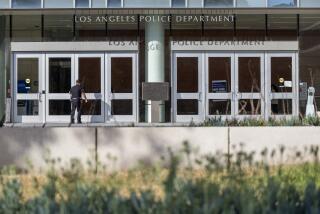LAPD Tightens Rules on Use-of-Force Probes
- Share via
Los Angeles Police Chief William J. Bratton commanded 88 top-ranking officers Wednesday to tighten procedures when investigating the serious use of force and to move decisively to separate officers to prevent any public perception that they conferred.
Bratton said the move was to help avoid a repeat of what happened in the flashlight beating of car-theft suspect Stanley Miller in Compton, where supervisors took about 45 minutes to decide it was a serious use-of-force incident and to separate officers.
The delay in separating the eight officers involved at the scene has led to allegations of a coverup.
Bratton directed his commanders to immediately implement the highest level of review if there was any doubt about whether officers’ actions could lead to a suspect’s death.
During such a probe, known as a categorical use-of-force investigation, officers must be separated and interviewed individually.
Bratton’s briefing, detailing mandatory action, came in the form of a four-page written guideline and an oral presentation to assembled command staff at the Police Academy. Bratton said his new directive was designed “to help clear up some of the confusion that was evident” in the Miller investigation, which is continuing.
It was Bratton’s second reform in 24 hours stemming from the June beating of Miller. Tuesday, Bratton announced that he would soon ban large metal flashlights, such as the one used in the Miller beating.
In explaining his most recent decision, Bratton said it was far easier to downgrade an investigation rather than to upgrade one.
His announcement dealt with sensitive elements in the Miller investigation, such as whether the delay before officers were separated provided some with the opportunity to confer and misstate what happened in the incident, and whether supervisors adequately guarded against collusion among officers facing potential allegations of wrongdoing.
Bratton did not publicly address that issue when he first announced the new policy Wednesday in an appearance before a special citizens commission created by Mayor James K. Hahn to monitor the Miller incident.
But committee head John Mack, president of the Los Angeles Urban League, said the officers in the Miller case had “a lot of time to get their story together.”
Mack praised Bratton’s action. “This is a very significant revision,” he said in an interview. “It errs on the side of caution and doesn’t allow officers to confer.”
A special order requiring officers in potential deadly force cases to be separated immediately before they are interviewed was implemented last year.
“We are the only police department in America that has that requirement,” Bratton told the committee.
Miller was allegedly driving a stolen car June 23 when he was spotted by LAPD officers, who gave pursuit. He abandoned the car and fled on foot before stopping in a Compton creek bed and putting his hands over his head.
Officer Phillip Watson was seen pulling out his gun and re-holstering it before tackling Miller. A second officer, David Hale, then jumped on Miller. A third officer, John Hatfield, was shown kicking at Miller before hitting him 11 times with a flashlight as Miller lay on the ground.
Hatfield, according to sources, told investigators that he delivered those strikes because Hale yelled “Gun!” Three other officers -- Watson, Peter Bueno and Todd Behrens -- told investigators they also heard the cry, according to an LAPD source.
Hale told investigators that he yelled because he felt a hard object in Miller’s pocket that was later listed on the police report as wire cutters, according to sources.
But Bueno, through his attorney, told the department that he recovered the wire cutters from the car Miller was driving.
In the Miller case, Bratton said that supervisors did not quickly decide whether the blows were directed at Miller’s head -- making the case serious enough to be considered a categorical use of force -- or whether it was a less serious “non-categorical use of force.”
The most serious force probes are handled by specially trained investigators of the LAPD’s Critical Incident Investigation Division and internal affairs.
More to Read
Sign up for Essential California
The most important California stories and recommendations in your inbox every morning.
You may occasionally receive promotional content from the Los Angeles Times.










